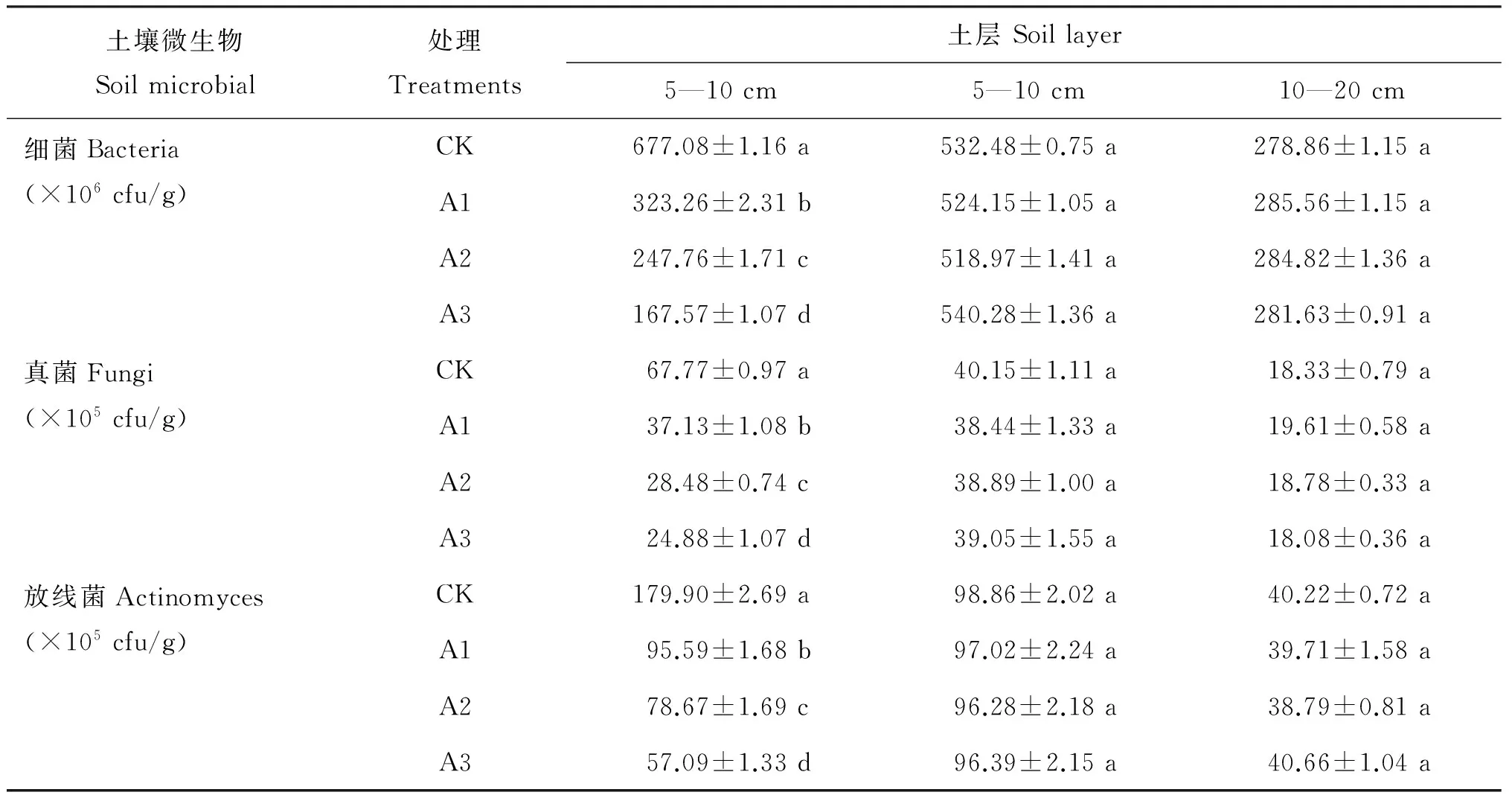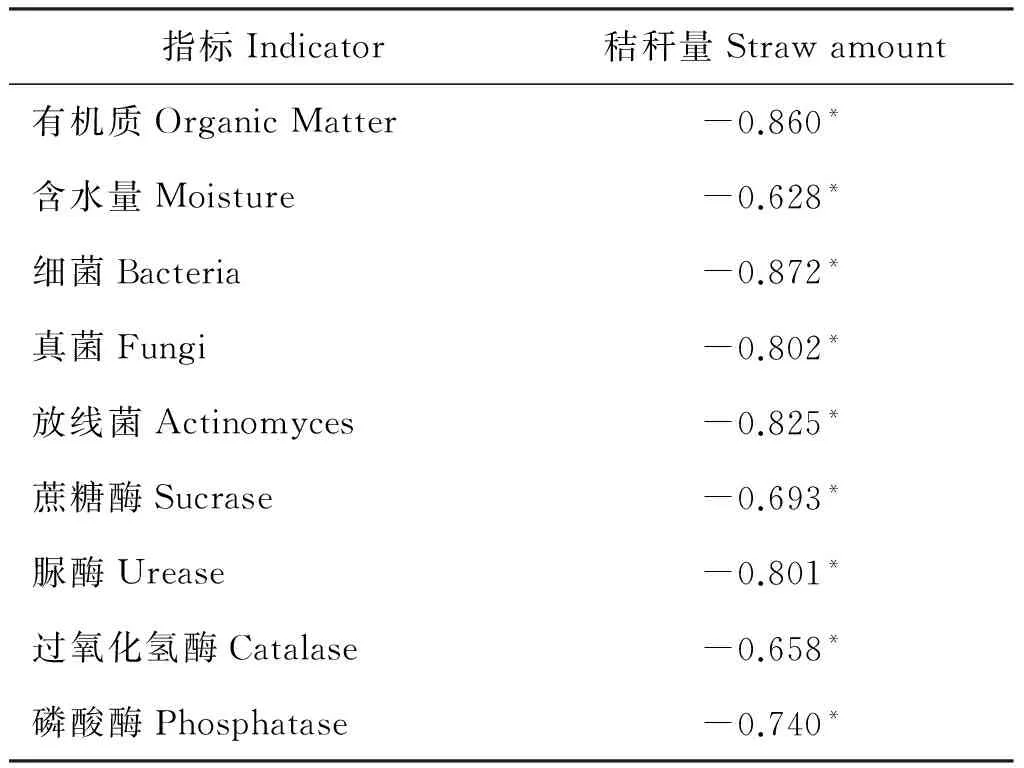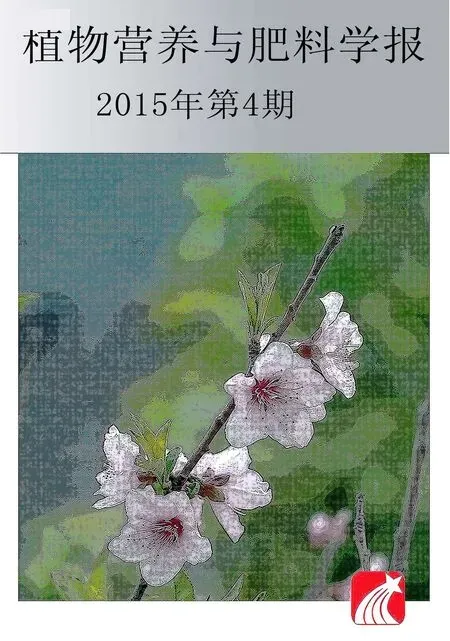小麦秸秆焚烧对土壤有机质积累和微生物活性的影响
田国成, 孙 路, 施明新, 吴发启*
(1 西北农林科技大学资源环境学院,陕西杨凌 712100;2 西北农林科技大学水土保持研究所,陕西杨凌 712100)
小麦秸秆焚烧对土壤有机质积累和微生物活性的影响
田国成1, 孙 路1, 施明新2, 吴发启1*
(1 西北农林科技大学资源环境学院,陕西杨凌 712100;2 西北农林科技大学水土保持研究所,陕西杨凌 712100)

秸秆焚烧; 有机质含量; 含水量; 微生物数量; 土壤酶活性

目前针对农田秸秆焚烧的报道较多,但多集中在大气环境变化方面,秸秆焚烧影响土壤环境的研究较少。本研究通过设置焚烧不同量的小麦秸秆试验,探究秸秆焚烧对耕层土壤有机质积累和微生物活性的影响,以期揭示秸秆焚烧对土壤环境产生的具体影响,为研究和客观评价农田秸秆焚烧提供一定参考。
1 材料与方法
1.1 试验地概况

1.2 试验设计
小麦收割留茬10 cm,焚烧秸秆前样地未进行翻耕,土地平整。将小麦秸秆均匀覆盖在土壤表面,然后进行焚烧。并对残留较多的部分进行补充焚烧,以保证不同焚烧处理的秸秆焚烧完全。试验设4个不同秸秆焚烧量处理:1)秸秆不焚烧,移出小区(CK);2)减量焚烧,秸秆焚烧量为平均秸秆产量的50%(0.24 kg/m2,A1);3)全量焚烧,秸秆焚烧量为平均秸秆产量(0.48 kg/m2,A2);4)增量焚烧,秸秆焚烧量为平均秸秆产量的150%(0.72 kg/m2,A3)。每处理3次重复,小区面积25 m2,随机区组排列,小区之间用田埂隔开。
1.3 样品采集与处理

1.3.2 测定项目和方法 土壤有机质采用重铬酸钾容量法(外加热法)[8];土壤含水量采用烘干法测定;土壤微生物数量采用稀释平板法测定[9],细菌用牛肉膏蛋白胨培养基,真菌用马铃薯葡萄糖琼脂培养基(PDA),放线菌用改良的高氏一号培养基。土壤蔗糖酶和过氧化氢酶活性参照关松荫的测定方法[10]。土壤蔗糖酶活性采用 3,5-二硝基水杨酸比色法测定,以37℃恒温培养 24 h 后1 g 土生成的葡萄糖的质量(mg)数表示;过氧化氢酶的活性采用高锰酸钾滴定法测定,以 1 g 土消耗的0.1 mol/L的高锰酸钾的毫升(mL)数表示;脲酶活性用苯酚—次氯酸钠比色法[11],以经37℃恒温培养24 h后1 g土中产生的NH3-N的毫克数(mg)表示,磷酸酶活性测定参照经过赵兰坡等[12]改进的磷酸苯二钠法,以在37℃恒温条件下培养24 h后1 g土中酚的质量(mg)表示。
1.3.3 数据处理 采用SPSS 18.0对数据进行方差分析和相关性分析,Excel 2010软件绘制图表。
2 结果与分析
2.1 秸秆焚烧对土壤有机质的影响
土壤有机质是土壤的重要组成部分[13],有机质经矿化产生的氮、磷等元素是作物吸收速效养分的主要来源[14]。一般认为有机质含量的减少将造成土壤质量的下降。表1结果表明, 在0—5 cm土层中有机质含量处理间表现出CK>A1>A2>A3的趋势,与CK相比, A1、A2和A3的有机质含量分别减少了6.37%、11.05%和19.47%,且差异显著(P﹤0.05)。A1、A2、A3处理之间相比较,A3处理与A1处理之间差异显著(P﹤0.05)。在5—10 cm和10—20 cm土层中,各焚烧处理的土壤有机质含量与CK之间均无显著差异。

表1 不同秸秆焚烧处理对土壤有机质的影响(g/kg)Table 1 Effects of different crops straw burning on soil organic matter
注(Note): 同列数据后不同字母表示处理间差异达5%显著水平 Values followed by different letters in a column are significant among treatments at the 5% level.
2.2 秸秆焚烧对土壤含水量的影响
土壤水分是土壤肥力中最活跃的因素之一[15],是植物吸收水分最重要的供给源,也是土壤中进行物理、化学及生物过程不可缺少的条件[16]。从表2可以看出, 0—5 cm土层的土壤含水量表现出CK>A1>A2>A3的趋势。A1、A2、A3处理分别比CK减少了22.15%、27.12%、39.19%,且均差异显著(P<0.05)。焚烧处理之间相比较,A3处理分别与A1、A2处理有显著差异(P<0.05)。5—10 cm和10—20 cm土层的土壤含水量各处理之间均无显著差异。
2.3 秸秆焚烧对土壤微生物的影响
土壤微生物与土壤肥力关系密切,经土壤微生物转化产生的营养是植物生长所需养分的重要来源[17]。土壤微生物对土壤质量变化的反应较灵敏[18],可以将土壤微生物数量作为研究土壤质量的

表2 不同秸秆焚烧处理对土壤含水量的影响(%)Table 2 Effects of different crops straw burning on soil moisture
注(Note): 同列数据后不同字母表示处理间差异达5%显著水平 Values followed by different letters in a column are significant among treatments at the 5% level.
一个重要指标。 表3显示,秸秆焚烧后0—5 cm土层的微生物数量均表现出CK>A1>A2>A3。与CK相比,A1、A2、A3处理的微生物数量均显著减少(P﹤0.05)。其中细菌数量依次减少52.26%、63.41%、75.25%,真菌数量依次减少45.21%、57.98%、 63.29%,放线菌数量依次减少46.87%、56.27%、 68.26%。在5—10 cm土层中,土壤微生物数量出现一定程度的减少,但未达显著水平(P>0.05)。10—20 cm,各处理的土壤微生物数量均无显著变化。总体上,在0—5 cm土层中的3大类微生物数量在3个焚烧处理之间有显著差异(P﹤0.05),而在5—10 cm和10—20 cm土层中3个焚烧处理之间无显著差异。

表3 不同秸秆焚烧处理对土壤微生物数量的影响Table 3 Effects of different crops straw burning on soil microbial quantity
注(Note): 同列数据后不同字母表示处理间差异达5%显著水平 Values followed by different letters in a column are significant among treatments at the 5% level.
2.4 秸秆焚烧对土壤酶活性的影响
土壤酶活性可以代表土壤养分转化和运移能力的强弱[19],较灵敏地指示有关土壤质量,是评价土壤肥力的重要指标。由表4可以看出,在0—5 cm土层中,土壤酶活性均表现为CK>A1>A2>A3的趋势。A1、A2、A3处理与CK相比土壤酶活性出现不同程度的降低,且大多差异显著(P<0.05)。蔗糖酶活性依次降低了14.19%、18.74%、30.75%,脲酶活性依次降低了7.81%、16.38%、25.48%,过氧化氢酶活性依次降低9.63%、20.80%、39.53%,磷酸酶活性依次降低11.36%、26.42%、40.44%。5—10 cm和10—20 cm土层中,各焚烧处理4种土壤酶与CK相比均无显著变化。在0—5 cm土层中,蔗糖酶和过氧化氢酶活性A3与A1、A2处理间差异显著(P﹤0.05);脲酶和磷酸酶活性各焚烧处理间均有显著差异(P<0.05)。5—10 cm和10—20 cm土层中,各处理间的差异不显著。

表4 不同秸秆焚烧处理对土壤酶活性的影响Table 4 Effects of different crops straw burning on soil enzyme activity
注(Note): 同列数据后不同字母表示处理间差异达5%显著水平 Values followed by different letters in a column are significant among treatments at the 5% level.
3 讨论
本研究结果表明,小麦秸秆焚烧造成表层(0—5 cm)土壤有机质含量减少,随着焚烧秸秆量的增多,有机质减少逐渐增多。主要是因为焚烧会使表层土壤有机质含量在短时间内迅速减少,影响其在土壤中的分布[20-21]。在被加热条件下土壤有机质会经历氧化分解等过程,最终转化为H2O和CO2挥发到大气中[22],从而损耗土壤中的有机质。而有机质氧化分解的程度与加热温度间呈正相关关系,研究发现,将土壤加热温度由220℃升高到350℃,有机质损失量由37%升高到90%[23],这表明火烧强度变大将引起有机质损失的增多。在本研究中,焚烧处理的土壤有机质含量平均减少16.18%,其中增量焚烧处理的减少量是减量焚烧处理的两倍,该结果与上述结论基本一致。尽管小麦秸秆焚烧会使部分有机质补充到土壤中,但该部分含量小于土壤中被分解掉的有机质总量[24],因此有机质含量表现出减少的趋势。同时,由于土壤是热的不良导体,尤其在土壤水分(具有较高的热容量)存在的情况下,焚烧产生的热量在土壤中传递深度较浅,剧烈而短暂的燃烧过程中热传递仅达几厘米[22]。本研究中,焚烧处理对土壤有机质的影响集中在0—5 cm表层土壤中。这与Trabaud等[25]的研究结论基本一致。土壤水分的变化从另一方面也印证了这一规律。小麦秸秆焚烧后,0—5 cm土层中的含水量平均减少了29.52%,由减量焚烧到增量焚烧,水分损失从22.15%升高到39.19%; 5 cm以下土层中土壤含水量无显著变化。这是由于火烧的热作用使土壤温度迅速升高,土壤水分受热而蒸发散失,并且温度越高蒸发量越大。综上所述,通过增加秸秆焚烧量可使火烧产生的热辐射对土壤有机质和水分的影响加强,但只在表层土中的影响显著。
土壤酶活性的发挥是以土体和土壤有机物质为基础的,焚烧对土壤有机物质和微生物群落的影响可通过分析土壤酶活性的变化来间接表达[29]。在本研究中,秸秆焚烧后0—5 cm土层中的蔗糖酶、脲酶、碱性磷酸酶和过氧化氢酶活性平均依次降低了21.13%、16.93%、23.21%、28.20%。温度高于70℃时,土壤酶作为蛋白质因热变性而活性降低。此外,温度升高引起的蛋白质降解作用(如脱酰胺和肽键断裂等)也是土壤酶活性降低的重要原因。这与Hernandez等[30]认为火后许多土壤酶的活性迅速降低的结论是一致的。
相关性分析表明,秸秆焚烧量与各指标间呈显著负相关关系(表5)。说明秸秆焚烧强度与其对土壤的影响程度间呈正比。而这种相关性是在热辐射对有机质和水分影响以及对微生物活性的抑制的基础上产生的。赵彬等[27]的研究未发现这种趋势,其原因是火烧后数月乃至数年时间土壤成分的差异和养分的损失得到了部分恢复。
4 结论
小麦秸秆焚烧短期内显著降低了0—5 cm表层土壤中有机质含量、含水量和细菌、真菌、放线菌数量以及蔗糖酶、脲酶、过氧化氢酶、磷酸酶活性,而对5—20 cm土层的影响不显著。小麦秸秆焚烧对土壤环境的影响强度随秸秆量的增多而加大。秸秆焚烧量与有机质含量、含水量、微生物数量及土壤酶活性之间呈显著负相关关系。鉴于秸秆焚烧对土壤肥力的长期效应以及对土壤环境理化性状影响的复杂性,焚烧对土壤有机质积累和微生物群落的影响还需长期定位试验来探讨。

表5 秸秆焚烧量与有机质含量、含水量、 微生物数量和土壤酶活性之间的相关性Table 5 Correlative coefficients between straw burning amount and soil organic matter content, moisture content, microbial quantity and enzyme activities
注(Note): *—P<0.05.
[1] 申源源, 陈宏. 秸秆还田对土壤改良的研究进展[J]. 中国农学通报, 2009, 25(19): 291-294. Shen Y Y, Chen H. The progress of study on soil improvement research with straw stalk[J]. Chinese Agricultural Science Bulletin, 2009, 25(19): 291-294.
[2] 韩鲁佳, 闫巧娟, 刘向阳, 胡金有. 中国农作物秸秆资源及其利用现状[J]. 农业工程学报, 2002, 18(3): 87-91. Han L J, Yan Q J, Liu X Y, Hu J Y. Straw resources and their utilization in China[J]. Transactions of the Chinese Society of Agricultural Engineering, 2002, 18(3): 87-91.
[3] 曹国良, 张小曳, 王亚强, 郑方成. 中国区域农田秸秆露天焚烧排放量的估算[J]. 科学通报, 2007, 52(15): 1826-1831. Cao G L, Zhang X Y, Wang Y Q, Zheng F C. Experimental investigation on emission factors of particulate matter and gaseous pollutants from crop residues burning[J]. Chinese Science Bulletin, 2007, 52(15): 1826-1831.
[4] 刘巽浩, 王爱玲, 高旺盛. 实行作物秸秆还田促进农业可持续发展[J]. 作物杂志, 1998, (5): 1-5. Liu X H, Wang A L, Gao W S. Implementing straw returning and accelerating agriculture sustained development[J]. Crops, 1998, (5): 1-5.
[5] 王丹, 屈文军, 曹国良, 等. 秸秆燃烧排放颗粒物的水溶性组分分析及其排放因子[J]. 中国粉体技术, 2007, 13(5): 31-34. Wang D, Qu W J, Cao G Letal. Analysis of water-soluble species in emission particulate from regional stalk burning and their emission factors[J]. China Power Science and Technology, 2007, 13(5): 31-34.
[6] 刘天学, 赵贵兴, 杨青春. 秸秆焚烧土壤提取液对大豆种子萌发和幼苗生长的影响[J]. 大豆科学, 2005, 24(1): 67-70. Liu T X, Zhao G X, Yang Q C. Effects of extracting solution from crop straw burning soil on the seed germination and seedling growth of soybean[J]. Soybean Science, 2005, 24(1): 67-70.
[7] 毕于运, 王亚静, 高春雨. 我国秸秆焚烧的现状危害与禁烧管理对策[J]. 安徽农业科学, 2009, 37(27): 13181-13184. Bi Y Y, Wang Y J, Gao C Y. Problems of burning straw and its management countermeasures in China[J]. Journal of Anhui Agricultural Sciences, 2009, 37(27): 13181-13184.
[8] 鲍士旦. 土壤农化分析[M]. 北京: 中国农业出版社, 2002. 25-38. Bao S D. Soil agricultural chemical analysis[M]. Beijing: China Agricultural Press, 2002. 25-38.
[9] 程丽娟, 薛泉宏. 微生物学实验技术[M]. 西安: 世界图书出版公司, 2000. 80-83. Cheng L J, Xue Q H. Experimental technique in microbiology[M]. Xi’an: World Book Publications, 2000. 80-83.
[10] 关松荫. 土壤酶及其研究法[M]. 北京: 农业出版社, 1986. 274-338. Guan S Y. Soil enzyme and its research methods[M]. Beijing: Agriculture Press, 1986. 274-338.
[11] 严昶升. 土壤肥力研究法[M]. 北京: 农业出版社, 1988. 276-276. Yan C S. Study method on soil fertility[M]. Beijing: Agriculture Press, 1988. 276-276.
[12] 赵兰坡, 姜岩. 土壤磷酸酶活性测定方法的探讨[J]. 土壤通报, 1986, 17(3): 138-141. Zhao L P, Jiang Y. Study on determination of soil phosphatase activity[J]. Chinese Journal of Soil Science, 1986, 17(3): 138-141.
[13] Schnitzer M. Soil organic matter-the next 75 years[J]. Soil Science, 1991, 151 (1): 41-58.
[14] Kononova M M. Soil organic matter, its nature, its role in soil formation and in fertility(2nd Edition)[M]. London: Pergamon Press, 1961. 5-20.
[15] 熊顺贵. 基础土壤学[M]. 北京: 中国农业大学出版社, 2001. 123-150. Xiong S G. Basic soil science[M]. Beijing: China Agricultural University Press, 2001. 123-150.
[16] 路文涛, 贾志宽, 张鹏, 等. 秸秆还田对宁南旱作农田土壤水分及作物生产力的影响[J]. 农业环境科学学报, 2011, 30(1): 93-99. Lu W T, Jia Z K, Zhang Petal. Effects of straw returning on soil water and crop productivity in the rainfed area of southern Ningxia, China[J]. Journal of Agro-Environment Science, 2011, 30(1): 93-99.
[17] 邵玉琴, 敖晓兰, 宋国宝, 等. 皇甫川流域退化草地和恢复草地土壤微生物生物量的研究[J]. 生态学杂志, 2005, 24(5): 578-580. Shao Y Q, Ao X L, Song G Betal. Soil microbial biomass in degenerated and recovered grasslands of Huangfuchuan watershed[J]. Chinese Journal of Ecology, 2005, 24(5): 578-580.
[18] Garcia C, Hemanderz T, Roldan A, Martin A. Effect of plant cover decline on chemical and microbiological parameters under mediterranean climate[J]. Soil Biology and Biochemistry, 2002, 34(5): 635-642.
[19] Bandick A K, Dick R P. Field management effects on soil enzyme activities[J]. Soil Biology and Biochemistry, 1999, 31(11): 1471-1479.
[20] Neff J C, Harden J W, Gleixner G. Fire effects on soil organic matter content, composition, and nutrients in boreal interior Alaska[J]. Canadian Journal of Forest Research, 2005, 35(9): 2178-2187.
[21] Howard P J A, Howard D M, Lowe L E. Effects of tree species and soil physico-chemical conditions on the nature of soil organic matter[J]. Soil Biology and Biochemistry, 1998, 30(3): 285-297.
[22] Certini G. Effects of fire on properties of forest soils: a review[J]. Oecologia, 2005, 143(1): 1-10.
[23] Fernandez I, Cabainero A, Carballas T. Organic matter changes immediately after a wildfire in an Atlantic forest soil and comparison with laboratory soil heating[J]. Soil Biology and Biochemistry, 1997, 29(1): 1-11.
[24] 黄兆琴, 胡林潮, 史明, 等. 水稻秸秆燃烧对土壤有机质组成的影响研究[J]. 土壤学报, 2012, 49(1): 60-67. Huang Z Q, Hu L C, Shi Metal. Changes in composition of soil organic matter after burning of straw[J]. Acta Pedologica Sinica, 2012, 49(1): 60-67.
[25] Trabaud L. The effect of fire on nutrient losses and cycling in a Quercus coccifera garrigue (Southern France)[J]. Oecologia, 1994, 99(3-4): 379-386.
[26] DeBano L F, Neary D G, Ffolliott P F. Fire effects on ecosystems[M]. New York: Wiley, 1998. 20-45.
[27] 赵彬, 孙龙, 胡海清, 孙志虎. 兴安落叶松林火后对土壤养分和土壤微生物生物量的影响[J]. 自然资源学报, 2011, 26(3): 450-459. Zhao B, Sun L, Hu H Q, Sun Z H. Post-fire soil microbial biomass and nutrient content of Larix gmelinii forest in autumn[J]. Journal of Natural Resources, 2011, 26(3): 450-459.
[28] Kim E J, Oh J E, Chang Y S. Effects of forest fire on the level and distribution of PCDD/Fs and PAHs in soil[J]. Science of The Total Environment, 2003, 311(1-3): 177-189.
[29] Boerner R E J, Brinkman J A, Smith A. Seasonal variations in enzyme activity and organic carbon in soil of a burned and unburned hardwood forest[J]. Soil Biology and Biochemistry, 2005, 37(8): 1419-1426.
[30] Hernandez T, Garcia C, Reinhardt I. Short-term effect of wildfire on the chemical, biochemical and microbiological properties of Mediterranean pine forest soils[J]. Biology and Fertility of Soils, 1997, 25(2): 109-116.
Effect of wheat straw burning on soil organic matter accumulation and microbial activity
TIAN Guo-cheng1, SUN Lu1, SHI Ming-xin2, WU Fa-qi1*
(1CollegeofResourcesandEnvironment,NorthwestA&FUniversity,Yangling,Shaanxi712100,China;2InstituteofSoilandWaterConservation,NorthwestA&FUniversity,Yangling,Shaanxi712100,China)
【Objectives】Open burning of agricultural waste is practiced to clear the surface biomass from land, to control pests and diseases, and to return some nutrients. Emissions from field burning activities deteriorate local air quality and seriously impede agricultural development. Recently many studies had been conducted to assess air pollution caused by straw burning. However, data are relatively limited in change of soil physical and organic subsequent to straw burning. Topsoil of different straw burning quantity was collected to study the immediate effect of straw burning on content of soil organic matter and soil microbial activity. 【Methods】 A field experiment was established in June 2012. The experimental treatments included 4 levels of amount of burned wheat straw: no burning (CK), decrement group (0.24 kg/m2, A1), normal group (0.48 kg/m2, A2) and increment group (0.72 kg/m2, A3). The wheat straw was put evenly over soil surface and then was burned, and the remained wheat straws were additionally burned in order to make straw burnt completely. After five hours, when soil temperature had returned to normal, soil samples were collected from 0-5, 5-10 and 10-20 cm depth of soil in each treatment and analyzed through laboratory experiment. To elucidate the specific effect of burning wheat straw on soil environment, change of indicators, soil organic matter content, moisture content, microorganism quantity and enzyme activities in each layer of soil, were analyzed. 【Results】 Burning wheat straw had significant influence on topsoil. The indicators of soil constituents were reduced with different degrees in different treatments. In the layer of 0-5 cm, the content of soil organic matter and moisture was reduced by 6.37%-19.47% and 22.15%-39.19% respectively. The quantities of bacteria, fungi and actinomyces were respectively decreased by 52.26%-75.25%, 45.21%-63.29%, 46.87%-68.26%. Activities of sucrase, urease, catalase and phosphatase were decreased by 14.19%-30.75%, 7.81%-25.48%, 9.63%-39.53% and 11.36%-40.44% respectively. There were significant differences between most combustion treatments and the control, while there was no significant difference in the 5-20 cm soil layer. The content of each indicator was decreased in the order of A3>A2>A1. The combustion treatments with different amount of straw mostly had significant difference between each other. The correlation analysis indicated that amount of straw burning had significantly negative correlations with soil organic matter content, moisture, soil microbial quantity and soil enzyme activity. 【Conclusions】 The results indicated that wheat straw burning significantly reduced soil organic matter content and soil microbial activity in topsoil (0-5 cm) in a short time, and the impact strength was proportional to the amount of burned straw. In the layer of 5-20 cm, the effect of the straw burning was small. The correlation analysis indicated that straw burning amount had significantly negative correlations with soil organic matter content, moisture, soil microbial quantity and soil enzyme activity. Due to long-term effect of straw burning on soil fertility and the complexity of the effect on the physical and chemical properties in soil environment of straw burning, long-term in-situ study should be carried out to better assess effect of wheat straw burning in field.
straw burning;soil organic matter content;soil moisture;soil enzyme activity; microbial quantity
2014-04-03 接受日期: 2014-06-30 网络出版日期: 2015-05-07
“十二五”国家科技支撑项目(2012BAD14B11)资助。
田国成(1987—),男,河北兴隆人,硕士研究生,主要从事土地资源利用与管理方面的研究。 E-mail: 905098882@qq.com * 通信作者 E-mail: wufaqi@263.net
S153.6+2; S154.3
A
1008-505X(2015)04-1081-07

